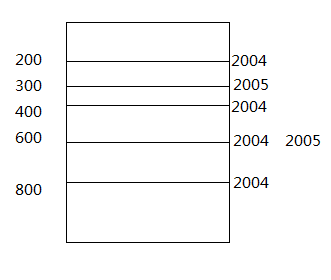Description
ACM(Advanced Computer Machine)是一种新出的计算机硬件系统,它正面临上市,但是缺少一种操作系统来配合它独特的硬件。所以,公司决为它开发一种新的操作系统。在这个操 作系统中,所有的进程都用PID来表示,它是一个正整数,每个程序都有唯一的一个PID来区分。因为它是一个分时操作系统,所以每个程序都有一定的时间, 所以系统需要写一个程序执行的序列。你作为这个开发小组一员,将负责写一个程序来生成这个序列。
ACM的一条指令Register是双字节指令,用来注册一个程序的运行,格式是这样的:
Register PID TIME
PID是程序的PID号,TIME这个PID所对应的程序运行的时间间隔(单位为MS)。PID,TIME是正整数。
另一条指令是EndRegister,用来表示Register指令的结束。
最后是指令Run,格式如下:
Run NUM
NUM生成指令的长度。
例如:
Register 2004 200
Register 2005 300
EndRegister
Run 5
那么程序执行的序列是:
2004
2005
2004
2004
2005
Input
第一行有一个正整数n,表示有几个测试数据。
每一个测试数据包含一组指令(Register,EndRegister,Run),对于每一组数据,0<PID<=2^16,0< TIME<=1000,0<NUM<=10000。你可以假定没有超过1000条的Register指令,并且只有一条 EndRegister和Run指令。
如果有几条指令同时发生,那么按他们的PID大小,从小到大的输出。
Output
对于每一组测试数据,第一行输出是第几个数据”test case n:”,之后的NUM行输出生成的指令。两组数据之间空一行。
Sample Input
2
Register 2004 200
Register 2005 300
EndRegister
Run 5
Register 2004 100
Register 2005 200
EndRegister
Run 6
Sample Output
test case 1:
2004
2005
2004
2004
2005
test case 2:
2004
2004
2005
2004
2004
2005
思路上还是比较清楚的
1、建立结构体包括PID 和TIME
2、录入数据
3、控制数据输出
在第二步骤时遇到一些小麻烦,其实本题只需要验证EndResigter就可以了。不需要管是不是输入的是Resigter
1 | while(1){ |
在C语言中直接用scanf是最直接有效的,起初还打算用sscanf或者gets(),发现错误越陷越深。
第三步骤是重点
1 | int last[10000]; |
需要用到last表记录每次运行一个进程是寻找最优进程的权值。就是说每次运行过一次进程之后last会自增。
last初始值为1,即该进程j开始下次运行总共所需时间间隔temp[j].TIME * last[j] 。 那么这个时间最小的进程就是即将可以运行的进程。
我们通过以下图表可以看到运行过程:

通过此图可以看到进程执行过程的时间其实是忽略不计的,主要时间消耗在时间间隔。并且每一个程序的时间间隔都是相互独立的,并没有互相影响。即计算机每运行200ms就可以有一次执行PID 2004的机会,每运行300ms就有一次执行PID 2005的机会。 只有当600ms时即可以执行PID 2004 又可以PID 2005的时候才会选择PID 较小的优先执行。
通过以上分析,我们建立last数据记录每一个进程执行次数,通过计算执行次数*每次执行所需的时间 可以得出次进程下一次执行会在那个时间点,那么只需要找到最小的一个执行时间点 ,执行此进程即可。
附源程序:
1 |
|